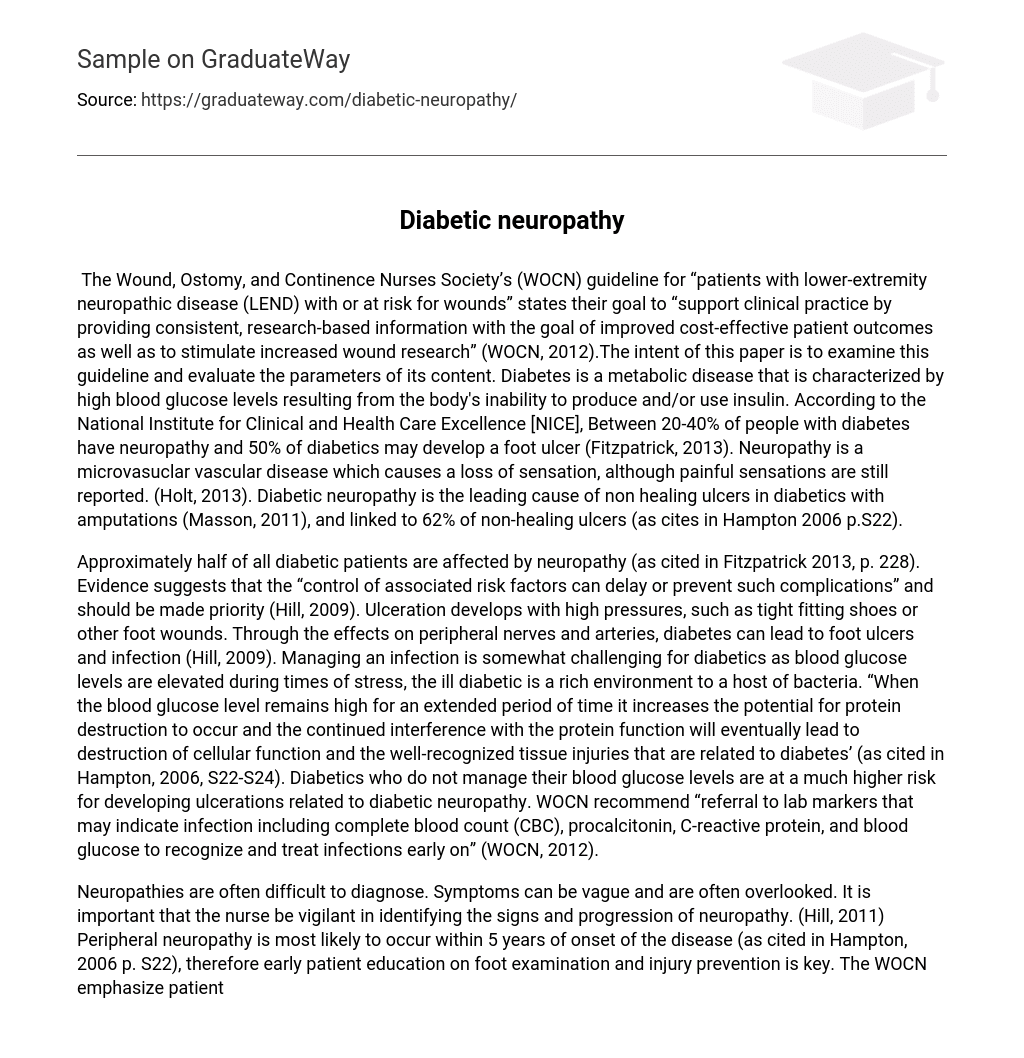The Wound, Ostomy, and Continence Nurses Society (WOCN) has developed a guideline for patients with lower-extremity neuropathic disease (LEND) who are at risk of or already have wounds. The purpose of this guideline is to provide consistent, evidence-based information to improve patient outcomes and stimulate further research on wounds (WOCN, 2012). This study aims to evaluate the content parameters of WOCN’s LEND guideline. Diabetes is a metabolic condition characterized by high blood sugar levels due to insufficient insulin production or utilization. According to the National Institute for Clinical and Health Care Excellence [NICE], 20-40% of individuals with diabetes experience neuropathy, and 50% may develop foot ulcers (Fitzpatrick, 2013). Neuropathy, a microvascular disease, causes reduced sensation but can still result in pain sensations (Holt, 2013). Diabetic neuropathy is the primary cause of non-healing ulcers in diabetic patients requiring amputations; it contributes to around 62% of non-healing ulcers as mentioned in Hampton’s work from 2006 on page S22 (Masson, 2011).Approximately half of individuals with diabetes suffer from neuropathy, which can lead to complications like foot ulcers and infections (Fitzpatrick 2013; Hill 2009). It is important to prioritize controlling risk factors related to neuropathy in order to prevent or postpone these complications. Factors such as wearing tight shoes or having foot wounds can increase pressure on the feet and contribute to the development of ulcers. Diabetic patients face challenges in managing infections because high levels of blood glucose during stressful periods create a favorable environment for bacterial growth. Prolonged elevated blood glucose levels can also damage proteins and interfere with their function, resulting in tissue injuries characteristic of diabetes (Hampton 2006, S22-S24). Properly managing blood glucose levels is crucial for diabetics in order to decrease the risk of developing ulcerations caused by diabetic neuropathy. The WOCN recommends using lab markers like complete blood count (CBC), procalcitonin, C-reactive protein, and blood glucose tests to identify and treat infections at an early stage (WOCN 2012).
Diagnosing neuropathies can often be challenging, as the symptoms are usually vague and easily overlooked. It is crucial for nurses to be vigilant in recognizing the signs and progression of neuropathy (Hill, 2011). According to Hampton (2006, p. S22), peripheral neuropathy is most likely to occur within 5 years of the disease’s onset. Therefore, early patient education on foot examination and injury prevention is essential. The WOCN emphasizes the importance of incorporating daily cleansing, moisturizing, self-foot examination, and wearing appropriate footwear for both indoor and outdoor activities. Additionally, patient teaching should address smoking cessation and counseling, adopting a personalized fitness program, implementing targeted nutritional therapy, and providing vitamin supplementation to aid in controlling blood sugar levels. Despite the extensive research conducted by the WOCN guidelines, which includes specific offloading procedures and debridement for ulcers, there is a lack of strategic protocol implementation and consideration for the diabetic wound population as a whole.
According to Masson (2011), elderly and poor diabetics with ulcers caused by neuropathy face difficulties in controlling their glucose levels due to socioeconomic factors. This specific group is more prone to amputations, as there exists a direct connection between rates of amputation and social deprivation. Consequently, it becomes crucial for nurses to educate diabetic patients about the significance of maintaining consistent glucose control and foot care, especially during periods of illness. Moreover, embracing a healthy lifestyle and undergoing comprehensive annual check-ups play essential roles in effectively managing any complications related to diabetes.





